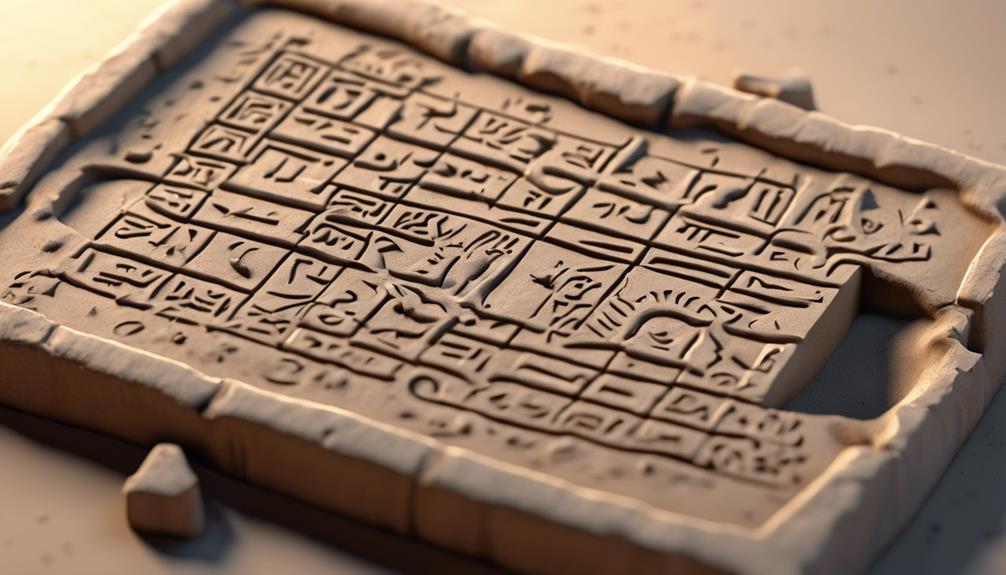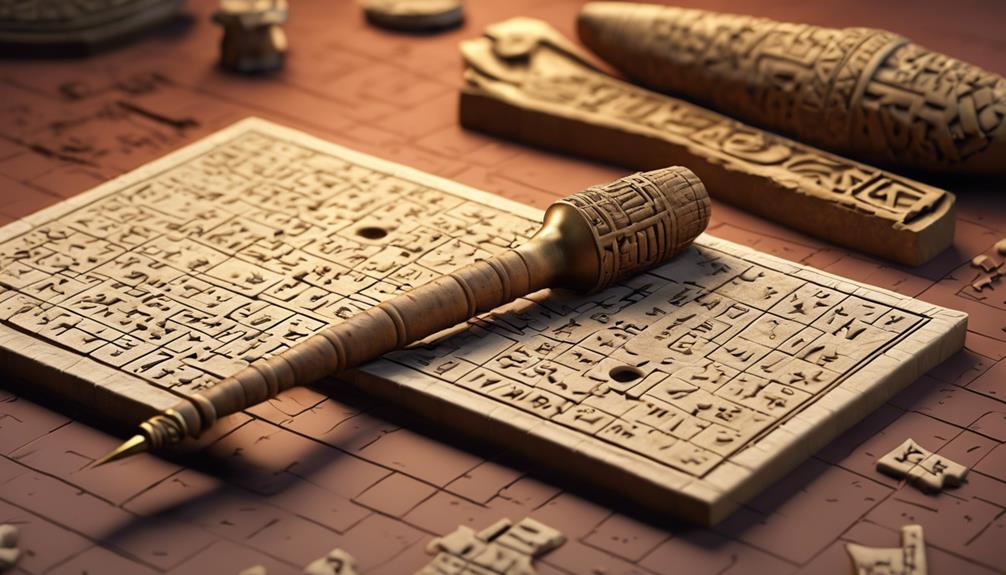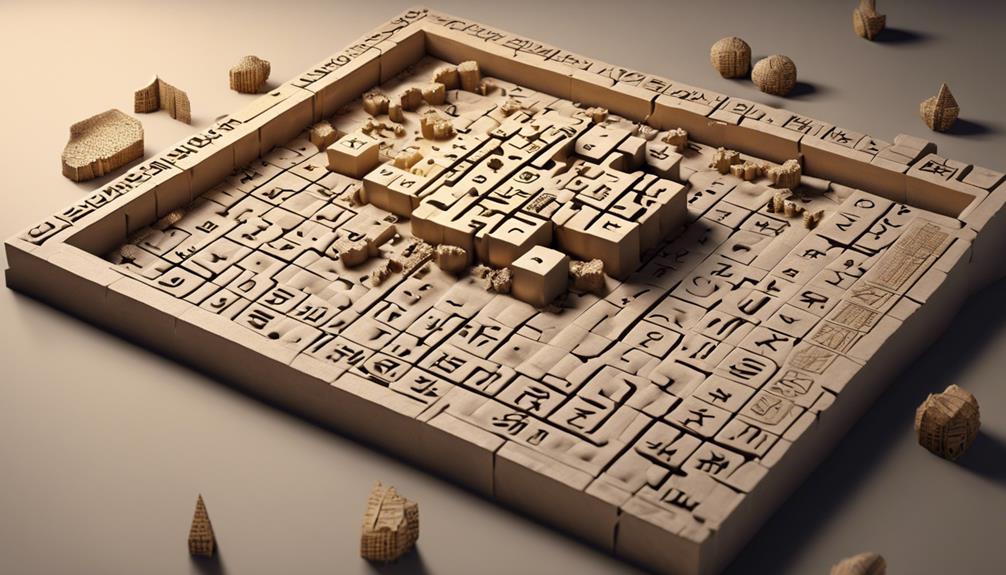In your search for 'Cuneiform Tool' crossword clue, consider the unique characteristics of these ancient Mesopotamian instruments. Scribes used tools with wedge-shaped tips crafted from reed stalks or soft stones to meticulously inscribe clay tablets. The varying shapes, from simple to intricate, allowed for precise markings through pushing, twisting, and pulling techniques. Mastery of these tools was crucial for preserving knowledge and history through the intricate cuneiform script. Understanding these tools opens a window into the fascinating world of ancient writing systems and cultural heritage.
Key Takeaways
- Cuneiform tools had wedge-shaped tips.
- Tools were made of reed stalks or soft stones.
- Scribes used various tool shapes for inscribing.
- Techniques included pushing, twisting, and pulling.
- Mastery of tools was crucial for cuneiform writing.
Origins of Cuneiform Writing

The origins of cuneiform writing can be traced back to ancient Mesopotamia, evolving from early pictographs into a sophisticated system of characters representing syllables and words. The development timeline of cuneiform spans over several millennia, with its earliest forms dating back to around 3400 BCE.
Initially used for bookkeeping and record-keeping purposes, cuneiform gradually transformed into a versatile script that encompassed various aspects of Mesopotamian life, such as literature, law, and religion.
The cultural significance of cuneiform can't be overstated. As one of the earliest known forms of writing, cuneiform played a pivotal role in the advancement of human civilization. It enabled the recording of historical events, the dissemination of knowledge, and the preservation of cultural heritage.
The decipherment of cuneiform tablets has provided invaluable insights into ancient Mesopotamian societies, shedding light on their language, customs, and beliefs.
Over time, cuneiform writing underwent significant changes, adapting to the linguistic nuances of different Mesopotamian cultures. Its widespread use across the region attests to its importance as a means of communication and documentation.
The legacy of cuneiform endures to this day, serving as a tribute to the ingenuity and creativity of the ancient Mesopotamians.
Characteristics of Cuneiform Tools
Among the distinctive features of cuneiform tools are their wedge-shaped tips, which were vital for creating impressions on clay tablets. These tools were primarily made of reed stalks or cut from a soft stone like flint. The use of materials like reeds allowed for a flexible yet sturdy tool that could withstand the pressure needed to create the intricate markings of cuneiform script. The wedge-shaped tips were essential as they enabled scribes to press into the clay at various angles, creating the characteristic triangular markings of cuneiform.
In terms of shapes, cuneiform tools varied from simple triangular tips to more complex multi-pronged ends. The diversity in tool shapes catered to the intricate nature of cuneiform script, which required a range of strokes and markings to convey different meanings. Scribes utilized these tools with precision, carefully imprinting the clay tablets with a combination of straight lines, curves, and wedges to form the complex script.
The markings left by cuneiform tools weren't only functional but also aesthetically appealing. The techniques employed by scribes involved a combination of pushing, twisting, and pulling the tools across the clay surface to create uniform and visually striking inscriptions. The mastery of these tools and techniques was essential for the preservation and transmission of knowledge through cuneiform writing.
Famous Cuneiform Artifacts

Cuneiform artifacts that have garnered significant attention include the Rosetta Stone and the Cyrus Cylinder. These famous cuneiform tablets hold immense historical significance, providing insights into Ancient Mesopotamian writing and culture.
The Rosetta Stone, discovered in 1799, contains a decree issued in 196 BC in three scripts – Ancient Egyptian hieroglyphs, Demotic script, and Ancient Greek. This artifact was pivotal in deciphering Egyptian hieroglyphs.
Another renowned artifact, the Cyrus Cylinder, is a cuneiform clay cylinder from the 6th century BC. It bears an inscription attributed to Cyrus the Great, detailing his conquest of Babylon and his policy of religious freedom. The cylinder is considered one of the earliest charters of human rights.
In addition to tablets, cuneiform cylinder seals are essential archaeological artifacts. These seals were used to authenticate documents and mark ownership. The seals typically feature intricate designs and inscriptions in cuneiform script, serving as personal signatures for Mesopotamian individuals.
Studying these famous cuneiform artifacts not only provides valuable historical information but also sheds light on the development of writing systems and the political and social structures of ancient civilizations.
Deciphering Cuneiform Script
Understanding the intricacies of deciphering cuneiform script requires a keen eye for detail and a thorough knowledge of linguistic and archaeological principles. The translation challenges inherent in decoding cuneiform arise from the vast array of symbols used, each with multiple meanings depending on context.
Historically, revealing these ancient scripts has provided invaluable insights into the civilizations of Mesopotamia, shedding light on details about governance, religion, and daily life.
Symbol meanings in cuneiform texts can vary greatly, adding layers of complexity to the translation process. Each wedge-shaped symbol, or 'cuneiform,' represents a sound or concept, with some symbols having multiple meanings depending on their placement within a word. Deciphering these nuances is essential to accurately interpreting the intended message of the inscriptions.
The cultural impact of deciphering cuneiform script can't be overstated. By disclosing the secrets of these ancient writings, scholars have gained a deeper understanding of Mesopotamian society and its contributions to human history. The ability to read cuneiform texts has allowed for the preservation and dissemination of invaluable knowledge that would otherwise have been lost to time.
Modern Uses of Cuneiform Symbols

In contemporary times, cuneiform symbols find practical application in various academic fields and artistic endeavors. One way these ancient symbols are being utilized in the modern world is through the development of digital cuneiform fonts. These fonts allow scholars, historians, and enthusiasts to type and display texts in cuneiform script digitally, aiding in research and educational efforts related to ancient Mesopotamian civilizations.
Moreover, cuneiform symbols have inspired unique fashion trends, where designers incorporate these ancient characters into modern clothing and accessories. This fusion of historical script with contemporary fashion showcases a blend of tradition and innovation, appealing to individuals interested in both ancient history and cutting-edge style.
To highlight the dual utility of cuneiform symbols in academia and the arts, the table below illustrates the diverse applications of these ancient script forms:
| Application | Description |
|---|---|
| Digital Cuneiform Fonts | Used for typing and displaying texts in cuneiform script digitally for research and education. |
| Cuneiform Inspired Fashion | Incorporating cuneiform symbols into modern clothing and accessories for unique fashion trends. |
The adaptation of cuneiform symbols in digital fonts and fashion trends demonstrates the enduring relevance and adaptability of this ancient writing system in the contemporary world.
Conclusion
You've learned about the origins of cuneiform writing, the characteristics of cuneiform tools, famous artifacts, deciphering the script, and modern uses of cuneiform symbols.
With this newfound knowledge, you can appreciate the complexity and significance of this ancient form of writing.
Whether studying history, archaeology, or linguistics, understanding cuneiform can provide valuable insights into the past and connections to the present.
Keep exploring the fascinating world of cuneiform and its enduring legacy.
